Khatam Kari, the Persian Art of Marquetry
Khatam Kari is one of the most famous Persian handicrafts. This Persian art is called marquetry in English. Basically, in Khatam Kari, the artist decorates the surface of wooden or metallic objects with pieces of wood. KhatamKari can be used to decorate various objects, such as boxes, frames, mirrors, trays, tables, chessboards, musical instruments, and even doors and windows. The designs can range from simple to complex, depending on the number and arrangement of the pieces. Some of the most common motifs are flowers, stars, birds, and arabesques. But the process of Khatam Kari is not as simple as it sounds. In this article, we will be talking about this art and how it’s made. Also, we will talk about the origin and special uses of this Persian handicraft. If you’re interested, you can see the process of making this handicraft and more on Narcis YouTube channel.
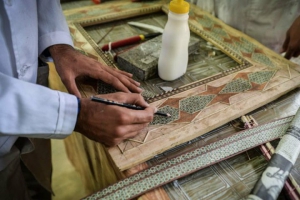
Decorating frame with Khatam
What Makes Khatam Kari Special Among Other Persian Handicrafts?
Khatam Kari is a beautiful art form that reflects Iran’s rich cultural heritage and aesthetic sensibility. It is also a testament to the craftsmanship of Iranian artisans who have preserved and developed this tradition for centuries. Overall, it is a delicate process that requires skill and patience. The works of Khatam Kari are not only for decoration but also for objects that are used daily. These objects range from tissue boxes to jewelry boxes and trays. On the other hand, Khatam Kari is not only a decoration but also a reflection of the worldview of its makers and admirers.
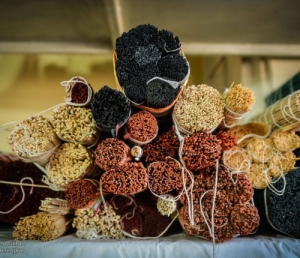
Thin rods of wood, bone, and metal for Khatam Kari
Persian Marquetry During the History
The word khatam means “incrustation” in Persian, and kari means “work”. KhatamKari is one of the oldest and most refined handicrafts in Iran. This Persian art dates back to at least the 15th century. This art was originally used to decorate royal palaces, mosques, shrines, and furniture. However, later became more accessible to the public. It was then that Khatam Kari was applied to various objects such as Quran boxes, frames, mirrors, chessboards, musical instruments, and more. This Persian art reached its peak of popularity during the Safavid dynasty (about 400 years ago) when it was patronized by the royal court. The Safavid capital of Iran, the city of Isfahan, became the center of KhatamKari production. Master craftsmen developed new styles and techniques to enhance the variety of this Persian art. Some of the most famous examples of Khatam Kari from this period are the doors and windows of the Sheikh Lotfollah Mosque, the Chehel Sotun Palace‘s ceiling, and Shah Abbas I’s tomb, one of the kings of the Safavid dynasty.
The decline of Khatam Kari
Khatam Kari declined after the fall of the Safavid dynasty. In fact, it was due to political instability and foreign invasions. However, it was revived in the 19th century by the Qajar dynasty (the dynasty after the Safavid dynasty). The Qajarids supported the art form as a national identity and cultural heritage symbol. Khatam Kari was also influenced by European styles and motifs during this period. It was due to the fact that during this era Iran opened up to trade and diplomatic relations with Western countries. Some of the most notable examples of KhatamKari from this period are the doors and windows of the Golestan Palace, the throne of Nasser al-Din Shah, and the jewelry box of Fath Ali Shah.
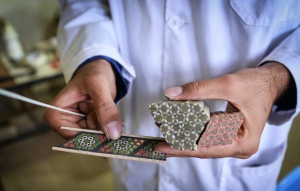
Layers of Khatamkari
Khatam Kari Today
Today, Khatam Kari is still practiced by a few artisans who preserve this ancient art form’s traditional methods. Khatam Kari is also taught in some schools and workshops as a way of promoting Iranian culture and handicrafts. It is recognized by UNESCO as an intangible cultural heritage of humanity. This Persian art is admired by many people around the world for its beauty.
The Meaning Behind the Designs & Color Patterns
The meaning behind Khatam Kari patterns is not only aesthetic but also symbolic and spiritual. The geometric shapes represent the order and harmony of the universe, as well as the unity and diversity of creation. The six-pointed star, for example, is a common motif in Islamic art that symbolizes God’s omnipotence and omniscience. The hexagon is also a symbol of perfection and balance in nature, as seen in honeycombs or snowflakes. The octagon is a transitional shape between the square (earthly realm) and the circle (heavenly realm). The polygon is a symbol of multiplicity and diversity within unity. This Persian craft, as mentioned before, showcases the creativity and craftsmanship of Persian culture. It is a testament to the beauty that can be achieved by combining simple elements into complex patterns.
Making Process of KhatamKari
The term Khatam Kari refers to both the art form and the technique of making it. The technique involves cutting thin rods of wood, bone (traditionally camel), and metal (such as brass) into precise shapes and sizes. Then, the artists glue them together to form a cylindrical bundle. They slice the bundle crosswise to produce thin veneers with star-shaped patterns or other geometrical patterns. These veneers are then glued onto a wooden or metal base and polished to create a smooth surface. The final product is a stunning mosaic of colors and shapes. For a better understanding of this amazing process, you can check out our YouTube video about Khatam Kari.
How To Take Care of the Works of Khatam Kari?
Khatam Kari is a precious art form. By following these tips, you can ensure that your Khatam Kari items will last for a long time:
- Keep them away from direct sunlight, heat, and humidity. Exposure to these elements can cause the wood to warp, crack, or fade. It can also affect the glue that holds the pieces together and make them loose or detached.
- Store your Khatam Kari items in a cool, dry, and dark place. If you want to display them, choose a spot that is not exposed to direct sunlight.
- Clean them gently. Do not use any water, soap, or chemicals as they can damage the wood or the inlay materials.
- If there are any stains or marks on your Khatam Kari items, consult a professional restorer for advice.
- Handle them with care. Khatam Kari items are fragile and can break or chip easily if dropped or hit. When you move or transport them, wrap them in bubble wrap or soft cloth and place them in a sturdy box. Avoid placing heavy or sharp objects on top of them or near them. Do not stack them on top of each other.
Where Can I Purchase the Works of Khatam Kari in Isfahan?
There are two main Bazaars in the city of Isfahan where you can find high-quality Khatam Kari shops and workshops. One is the traditional Bazaar of Qeysarieh and the other one is Hassan Abad Bazaar. These two Bazaars are connected. Before purchasing a work of Khatam Kari make sure it has a clean surface and even thickness. The beauty and value of Khatam Kari depend on the size and complexity of the patterns, as well as the quality and variety of the materials used. In some cases, up to 250 pieces can be fitted into one cubic centimeter of space. The smaller and finer the pieces, the higher the skill and artistry required. Some Khatam Kari works also feature paintings or calligraphy within the inlaid frames. You can also purchase it as a gift or a one-of-a-kind souvenir.

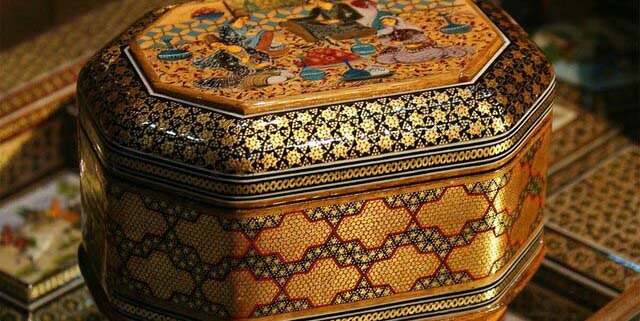

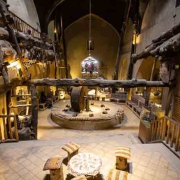

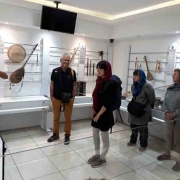
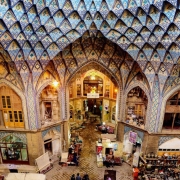

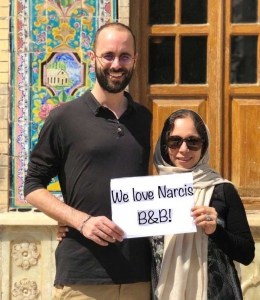




Leave a Reply
Want to join the discussion?Feel free to contribute!